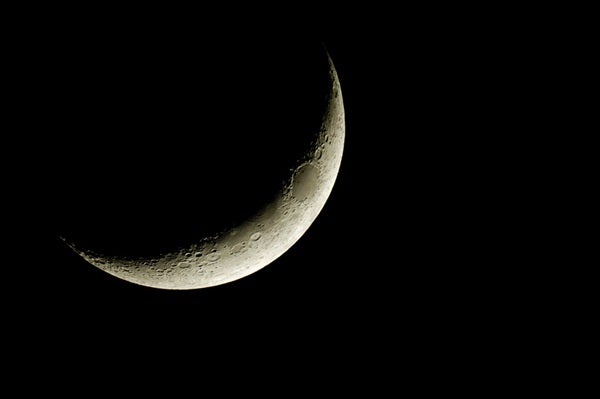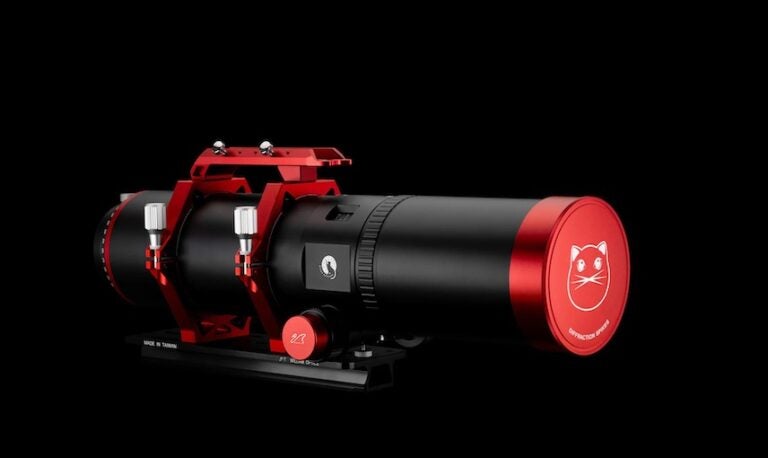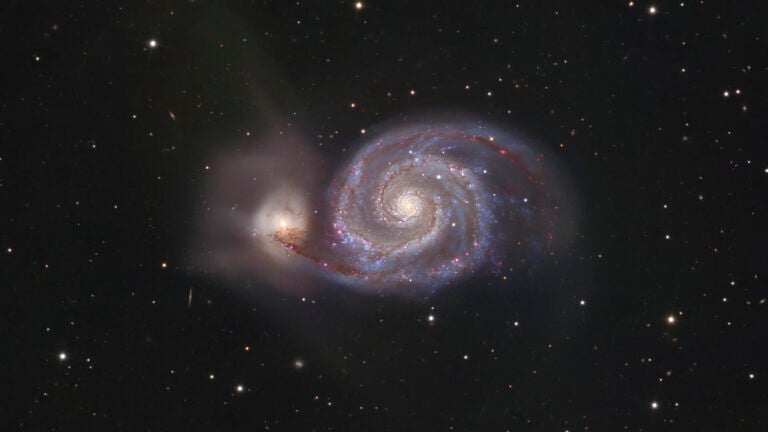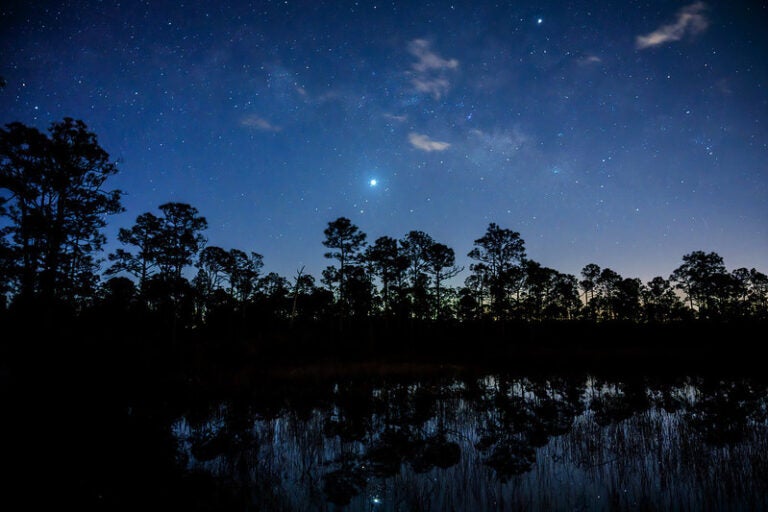Friday, July 6
The Big Dipper’s familiar shape lies high in the northwest as darkness falls these July evenings. One of the summer sky’s finest binocular double stars marks the bend of the Dipper’s handle. Mizar shines at 2nd magnitude, some six times brighter than its 4th-magnitude companion, Alcor. Even though these two are not physically related, they make a fine sight through binoculars. (People with good eyesight often can split the pair without optical aid.) A small telescope reveals Mizar itself as double — and these components do orbit each other.
If you ever thought the Sun’s distance controlled temperatures here on Earth, today should convince you otherwise. Earth reaches its most distant point from the Sun at 1 p.m. EDT. At this so-called aphelion, the two lie 94.5 million miles (152.1 million kilometers) apart, some 3.1 million miles (5.0 million km) farther away than they were at perihelion in early January. The Northern Hemisphere’s warm temperatures at this time of year arise because the Sun passes nearly overhead at noon; during winter, the Sun hangs low in the sky.
Saturday, July 7
Magnificent Saturn reached its peak 10 days ago, when it appeared opposite the Sun in the sky, and our view of the ringed planet remains spectacular. It is on display nearly all night among the background stars of northern Sagittarius, hanging in the southeastern sky as darkness falls and climbing high in the south by midnight local daylight time. Saturn continues to shine brightly, too, at magnitude 0.1. When viewed through binoculars, you’ll find the Trifid Nebula (M20) 4.2° to the west, with the even brighter Lagoon Nebula (M8) 1° south of the Trifid. Open cluster M25 resides 4.2° northeast of the planet and globular cluster M22 is 3.8° southeast of the ringed world. But the best views of Saturn come through a telescope, which reveals the planet’s 18″-diameter disk surrounded by a dramatic ring system that spans 42″ and tilts 26° to our line of sight.
Sunday, July 8
Although Jupiter reached opposition and peak visibility two months ago, it remains a stunning sight from evening twilight until it sets around 2 a.m. local daylight time. Jupiter shines at magnitude –2.3 and dominates the sky toward the south-southwest as twilight deepens. The gas giant resides among the background stars of Libra the Scales, 2.1° northwest of Zubenelgenubi (Alpha [a] Librae). If you view the planet through a telescope tonight, its disk spans 41″ and displays spectacular cloud-top detail.
Monday, July 9
Venus dominates the western sky after sunset. The dazzling object shines at magnitude –4.1 among the background stars of western Leo. Venus appears 14° high an hour after sundown and sets shortly before 11 p.m. local daylight time. And this evening, the solar system world meets Leo’s brightest star, 1st-magnitude Regulus. The planet appears 1.1° north (to the upper right) of the star and shines more than 100 times brighter, so binoculars will provide the best view of the conjunction. When viewed through a telescope, Venus appears 17″ across and two-thirds lit.
Tuesday, July 10
Mars remains a stunning sight all week. It rises around 10 p.m. local daylight time and climbs nearly 30° high in the south by 2:30 a.m. Although the Red Planet won’t reach opposition until the end of July, it appears noticeably brighter than it did just a week ago. Shining at magnitude –2.5, it appears brighter than Jupiter and ranks as the second-brightest point of light in the night sky after Venus. If you point a telescope toward Mars, you’ll see its 23″-diameter disk and perhaps a few subtle surface features — though most of these are currently obscured by a major dust storm.
The waning crescent Moon rises shortly before 3:30 a.m. local daylight time this morning. Earth’s satellite lies next to the V-shaped Hyades — the large star cluster that forms the head of Taurus the Bull. The Moon stands just 1° northeast of Taurus’ brightest sun, 1st-magnitude Aldebaran. From parts of Canada and the upper Midwest, Luna passes in front of this ruddy star.
Wednesday, July 11
Mercury pops out of the twilight glow this evening as the sky begins to darken. Look for it 30 minutes after sunset, when it lies 9° above the western horizon. The innermost planet should be fairly easy to spot because it shines brightly, at magnitude 0.4. (Use binoculars if you can’t see it with your naked eye.) Mercury lies 26° east of the Sun tonight, its greatest elongation for this evening apparition. Through a telescope, Mercury appears 8″ across and slightly less than half-lit.
Thursday, July 12
Today marks the peak of Pluto’s 2018 appearance. The distant world reaches opposition, which means it lies opposite the Sun in our sky and remains visible all night. It glows dimly at 14th magnitude, however, so you’ll need an 8-inch or larger telescope with good optics to spot it visually. Pluto currently lies in northeastern Sagittarius, some 0.2° west of the 6th-magnitude star 50 Sagittarii.
New Moon occurs at 10:48 p.m. EDT. At its New phase, the Moon crosses the sky with the Sun and so remains hidden in our star’s glare. At least, that’s what it will do for more than 99 percent of Earth’s population. But if you find yourself between southeastern Australia and Antarctica, you can watch the Moon pass in front of the Sun and cause a partial solar eclipse. From Hobart, Tasmania, the eclipse lasts from 2h52m to 3h56m UT, and the Moon blocks 10 percent of the Sun’s diameter at maximum. Remember that when viewing the Sun during a partial eclipse, you need to protect your eyes with a safe solar filter.
Friday, July 13
The Southern Delta Aquariid meteor shower starts to ramp up this week. The shower won’t peak until the end of July, but you should see some of its meteors in the hours before dawn. The best time to look is between 3 and 4 a.m. local daylight time, just before twilight begins. Viewing conditions are great the remainder of this week because the Moon is out of the morning sky. Unfortunately, our satellite will show a fat gibbous phase at the shower’s peak the night of July 29/30. To tell a Southern Delta Aquariid meteor from a random dust particle burning up in Earth’s atmosphere, trace the streak of light’s path backward. A shower meteor will appear to originate from the constellation Aquarius the Water-bearer.
The Moon reaches perigee, the closest point in its orbit around Earth, at 4:25 a.m. EDT. It then lies 222,097 miles (357,431 kilometers) away from us. Since perigee arrives less than six hours after New Moon, residents of coastal areas can expect to see tides rise higher than normal for the next couple of days.
Saturday, July 14
A slender crescent Moon passes 2° above Mercury in this evening’s sky. Binoculars should deliver the best views of the pair set against a colorful twilight sky.
Sunday, July 15
The Moon moves approximately 13° eastward relative to the starry background every 24 hours, and that motion carries it near Venus this evening. The crescent Moon appears just 2° to the brilliant planet’s right. The stunning duo stands 15° high in the west 45 minutes after sunset. This conjunction provides a nice photo opportunity. If you shoot the twilight scene before 9:30 p.m. local daylight time, you’ll also capture Regulus to the lower right and Mercury even closer to the horizon.












